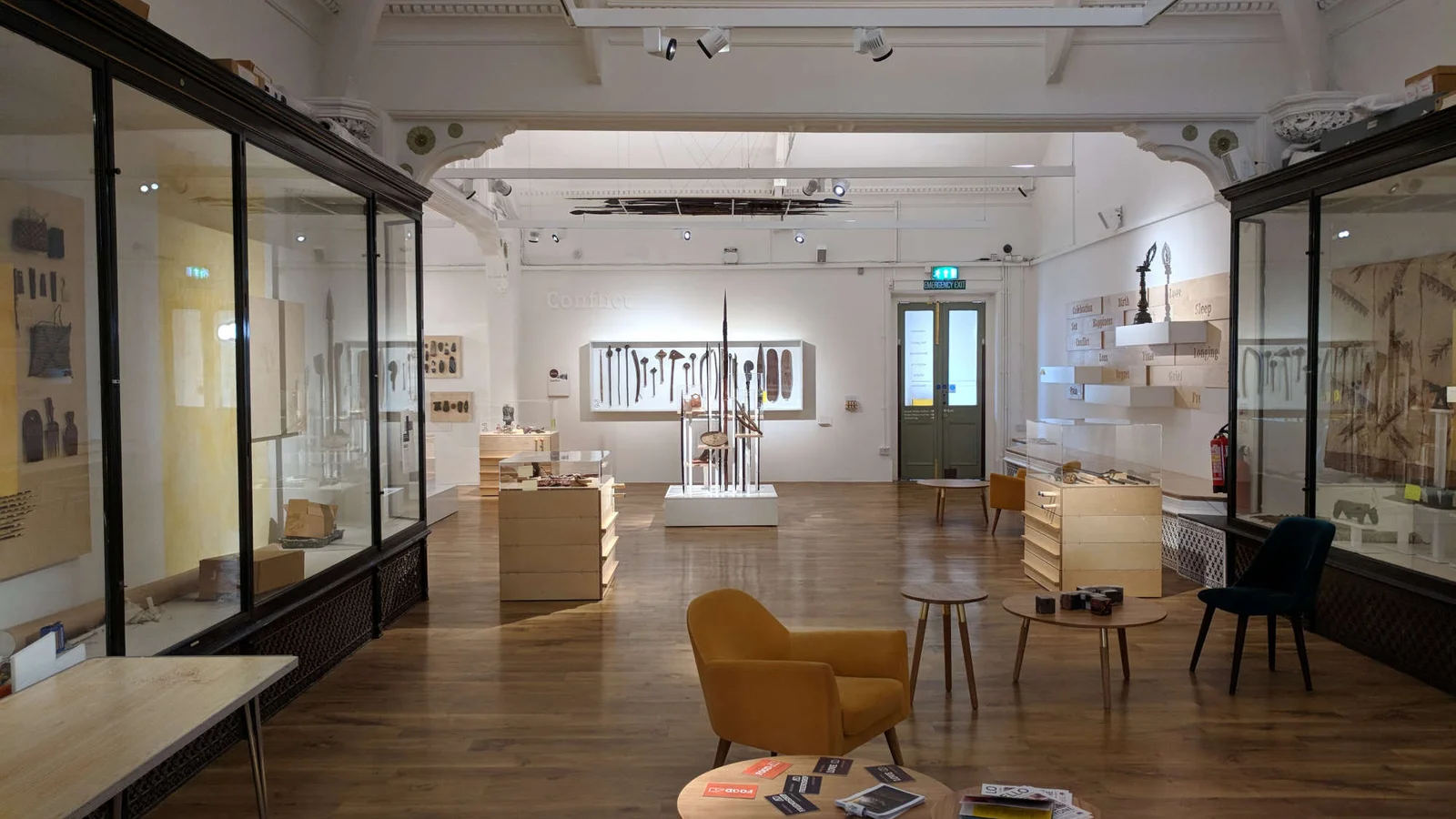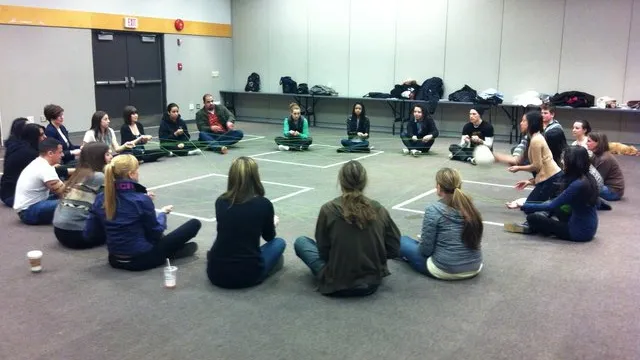Trauma-informed describes an ethical and clinical framework for ensuring the safety and well-being of people who are involved in any aspect of trauma expression, recovery, and healing, and in social justice initiatives that address traumatic themes. In the context of museum work, developing trauma-informed practices involves group consultations, staff workshops, and individual work that participants might undertake on their own as part of their personal journeys.
Because this work explicitly addresses the living ecology of the organization, knowledge development for trauma-informed practices ideally includes peers, colleagues, and leaders at every level. The Collections staff member handling residential school artifacts needs trauma-informed skills. So does the researcher conducting oral histories. So does the visitor services staff member who greets a residential school survivor at the door. So does the curator designing an exhibition about genocide. So does the executive making decisions about resource allocation. The skills look different in different roles, but they share common foundations: self-awareness, empathy, capacity for presence, understanding of how trauma works in the body and the nervous system.
Trauma-informed practice is not something we learn once and then possess. It is a continuous orientation, requiring ongoing attention, practice, and renewal. It involves learning to notice our own activation—the moment when a visitor's story or a colleague's distress begins to resonate with our own unresolved material. It involves developing strategies for staying grounded when emotions run high. It involves knowing when to step in, when to step back, and when to ask for help. All of this takes time, patience, and a willingness to keep learning.
The Personal Dimension
Normally, professional development training involves knowledge acquisition about facts, processes, and similar features of the outside world. Practices such as self-reflection, emotional awareness, empathy, and personal insight are not normally foundational to workplace training. Trauma-informed training is—must be—different. Trauma is a deeply emotional, evolutionary, and personal feature of the human experience. Our reactions to our personal traumas, and to the traumas of others, always evoke our own inner landscape of unique feelings, perspectives, and reactions.
Trauma-informed workplace training must account for these personal reactions and must assist participants in navigating what can often be a bewildering set of emotions and resulting behaviors. In most workplace settings, simply talking about feelings has historically been fraught with danger. The feelings surrounding trauma can be among the most powerful emotions we carry; handling them appropriately and safely must be of paramount importance in trainings such as this.
The circumstances most associated with the safe and effective management of traumatic material involve cultivating a sense of belonging, building trust, and establishing norms of emotional safety. When these conditions can be established, the training becomes safe, meaningful—and, often, therapeutic, though it is neither counseling nor therapy. Participants begin to understand that the work of trauma-informed practice starts with them, with their own inner landscape, before it extends outward toward others.
Skilled Persons
In professional environments of strong emotion and uncertain pathways, personal skills determine the outcomes. Those skills include, most fundamentally, self-awareness and empathy: how we stay in touch with ourselves and how we respond to others. These abilities require constant attention, reinforcement, and renewal. Effective personal skill also entails a variety of further capacities such as grounding, presence, self-regulation, containment, listening, and boundaries. And these, in turn, hinge upon the strategies we use to determine when and how we communicate and interact with others.
Considerations such as body language, voice tone, language, timing, pacing, and waiting all play crucial roles in challenging situations. If we misjudge or overlook one of these factors, the whole situation tends to escalate or fall apart. Getting it right is hard—and is the reason we use the word wisdom in describing people who manage these complexities with grace and consistency.
Effective trauma-informed training involves cultivation of the skills needed to understand ourselves and engage with others, as well as the development of strategies for situations shaped by the emotional reactions of other people (which is, actually, most situations). The training must provide space for practice, for feedback, for experimentation. It must normalize difficulty and uncertainty. It must create conditions where people can try skills, falter, receive support, and try again.
Personal First
Trauma-informed practices are not skills that we only apply to others in situations of stress or overwhelm. They are, rather, skills that we must first learn to apply to ourselves before we enter situations involving others. If we miss this crucial step, we risk harming both ourselves and other people.
The tactics we use in charged situations are based on, and must emerge from, our self-awareness. The strategies we use to navigate moments of emotional uncertainty are grounded in our own grounding. The dynamics that emerge between us and other people are built upon our attunement to our own feelings, thoughts, and reactions. This is all work of the self: personal, perhaps vulnerable, always delicate.
Accordingly, training must emphasize the importance of emotional safety for participants. They need to feel that they can be themselves, that they can explore and apply these skills in their own unique ways. There are no precise formulas or recipes in this work. Everyone is different and must find their own way through practice, helpful feedback, and collegial support. The skills, strategies and tactics of working with people don't come from outside. They involve work of the inner life, which is the most complex space of all.
Mitigating Risks of Harm
Many people in museum, gallery, and educational contexts have a general awareness of the meaning of terms such as trauma-aware and trauma-informed; many have participated in educational workshops about trauma. This is encouraging. However, the complexities of trauma—and the personal skills required to navigate them—cannot be fully captured with traditional educational methods. Attempting to do so can lead to ongoing problems.
People who learn the basics of trauma can develop the mistaken belief that applying this new knowledge to an actual situation involving trauma will be reliably helpful. Staff can develop a false sense of skill in approaching interactions with visitors or colleagues. They can mistakenly believe that a trauma-informed approach involves action toward others without requiring personal introspection, development, and trauma healing within themselves. They can approach empathy as an outward skill rather than an inward state of being. Many such complications may arise, and any one of them can cause harm to staff, visitors, and the wider community.
Trying to implement a trauma-informed approach by telling people about trauma—without supporting them in skill practice, self-reflection, and personal growth—is fraught with risks. It's like encouraging someone to step into the cockpit of a helicopter after reviewing the flight manual. Thinking about trauma and reading about trauma are not enough. Interacting with traumatized people as experiments in skill development can lead to unintended harm. This is a situation in which a little knowledge can be dangerous.
How we interact with others is mostly contingent upon how we deal with ourselves, and that foundation must be addressed in the context of any real skill development involving people. The duties of care, and the ethical obligations undertaken by participants who engage with this work, must develop alongside the personal and professional capacities as they emerge. This takes time. It requires patience, practice, and ongoing support—which is why the timeline for this project extends across multiple years rather than being compressed into brief workshops.
Practice in Context
Effective training happens in or near the actual environments where skills will be used. This principle—sometimes called representative learning design—recognizes that skills practiced in abstract or artificial settings often don't transfer well to real situations. A staff member who practices empathic listening in a quiet conference room may struggle to apply the same skills in a crowded gallery with ambient noise, time pressure, and the unpredictability of actual visitor encounters.
Accordingly, trauma-informed training at museums should include practice in the galleries themselves, in storage areas, at admissions, in meeting rooms with community partners—wherever the work actually happens. This doesn't mean staging crises or asking staff to practice on real visitors experiencing distress. Rather, it means simulating scenarios in realistic settings, with attention to the actual constraints and affordances of those environments. Where can someone take a visitor who needs to step away? What does it feel like to stand in a gallery for an entire shift? How does sound carry in different spaces? What objects or features of the environment might help someone ground themselves?
Practice should also include rotation of roles. Staff take turns being the visitor, the colleague in distress, the person offering support, the observer noticing patterns. This rotation builds perspective and empathy. It reveals how different approaches feel from the inside. It helps people understand that what seems helpful from one position may not feel helpful from another.
Variability should be intentional. Scenarios should vary in intensity, in the type of distress presented, in the presence or absence of complicating factors. Some should go smoothly; others should be deliberately difficult. This guided variability helps people learn to adapt rather than memorize scripts. It prepares them for the reality that no two situations are ever quite the same.
Feedback should be immediate and focused on patterns rather than isolated moments. After a practice scenario, the group discusses: What did you notice? What worked? What felt stuck? How might we approach this differently? The facilitator highlights patterns—I noticed several people moved toward offering advice. What might happen if we stayed with reflection instead?—and invites the group to experiment with alternatives.
Planning for Safety
This type of training is more complex, and more dynamic, than typical professional development seminars involving presentations and content delivery. This is much more personal, and perhaps more challenging for some people. It's important to be careful in doing this kind of training; you can make things worse while trying to make them better. These considerations entail an approach that is flexible as well as mindful.
The specific details of timing, group size, and content emphasis are best determined collaboratively to preserve safety and fit. What works for one group may not work for another. A cohort that has been together for years and trusts one another deeply can move faster and deeper than a newly formed group. A team that has recently experienced organizational trauma may need more time for safety-building before engaging with skill practice. The facilitator must attend to these dynamics and adjust accordingly.
Going forward, planning should continue to follow this flexible, co-designed approach. Check-ins with participants help gauge readiness and adjust pacing. Leadership briefings ensure alignment and support. Focused sessions for high-exposure teams (curation, research, collections, public-facing staff) acknowledge the particular challenges these roles entail. The structure should be firm enough to provide containment but flexible enough to meet people where they are.
Structure and Rhythm
This process has been developed through in-person workshops, in-person consultations, and virtual consultations. In practice, the sequence and pacing have been adapted to internal dynamics, with iterative check-ins, leadership briefings, and focused sessions for teams with high exposure to traumatic content. Future cycles can retain this structure while building in more peer-led practice and follow-up.
The rhythm of the work matters. Intensive workshops create momentum and depth, but momentum fades without ongoing reinforcement. Monthly virtual sessions maintain connection and provide space for questions, challenges, and celebrating small successes. Bi-weekly consultations allow for troubleshooting as staff encounter situations they don't yet know how to navigate. This rhythm—intensive work followed by sustained support—honors the reality that skill development happens over time, not all at once.
Documentation at each stage helps build institutional memory. After workshops, participants receive summaries of key concepts and practical tools. After consultations, decisions and action items are recorded and shared. This documentation serves multiple purposes: it reinforces learning, creates resources staff can return to, and provides material for onboarding new staff who join after initial training.
Building Internal Capacity
One of the explicit goals of this work is to build internal capacity to enable staff to support and train one another and facilitate ongoing skill development within the organization. Accordingly, the identified cohort refers to the group of staff who will have the opportunity to learn the skills required to assist their colleagues in developing trauma-informed museum practices.
This cohort should include people from diverse roles and departments: a curator, a Collections staff member, someone from visitor services, a researcher, an educator, perhaps someone from HR or administration. Diversity ensures that trauma-informed practices are understood and championed across the organization rather than being siloed in one area. It also ensures that when new situations arise, there are multiple perspectives available for responding thoughtfully.
Building capacity means more than training a few people and expecting them to train everyone else. It means creating systems that support peer learning: regular case discussions where staff share challenges and brainstorm responses together, mentorship pairings, opportunities for experienced staff to co-facilitate workshops with external experts before leading sessions on their own. It means recognizing and rewarding this work—making it a valued part of staff roles rather than extra labor squeezed into already full schedules.
Sessions for Leadership
Another goal is to include participants who are able to make decisions about positive change: executives, those in positions of management or leadership, and the board. How and when this is done—and who it includes—depends on the internal dynamics of the organization and is determined in consultation with those involved directly in the work.
Initial leadership sessions provide training in trauma-informed principles and practices tailored to current priorities, with time for reflection and follow-up. Leadership sessions are not simply information-sharing but opportunities for leaders to grapple with what trauma-informed practice means for their own roles: How do I model vulnerability without abdicating responsibility? How do I balance productivity demands with staff well-being? How do I advocate for resources when budgets are tight? What policies need changing, and how do I navigate that process?
Leadership engagement is crucial because leaders set tone, allocate resources, and make decisions that either enable or constrain trauma-informed practices. A leader who says "This is important" but doesn't allocate budget or time sends a message that the work is valued in words only. A leader who participates in training alongside staff, who admits their own struggles, who asks for feedback on their leadership—this person creates permission for the entire organization to engage authentically.
The Foundation for Everything That Follows
Trauma-informed training is fundamentally different from typical professional development because it requires participants to engage with their own inner landscape as the foundation for supporting others. It cannot be rushed, compressed into brief workshops, or treated as simple knowledge acquisition. It demands time, practice, emotional safety, and ongoing support. When done well, it builds the capacity for museums to be places where difficult work can be sustained—where staff develop the skills and self-awareness to navigate emotional intensity with grace, where mistakes become opportunities for learning, and where care for oneself and others becomes ordinary rather than exceptional.
Next
Guide Navigation
The introductory page of the guide provides the context and rationale for trauma-informed museum practices and includes an overview of each page.
Understanding Trauma in Museum Contexts explores how trauma operates as a complex, ecological phenomenon affecting visitors, staff, and community partners. It examines the neuroscience of trauma responses, the patterns that emerge from person-environment interactions, and why museums need this foundational knowledge.
Considerations for Trauma-Informed Training addresses the personal dimension of this work—why trauma-informed training must be fundamentally different from typical professional development, how to build skills safely, and the importance of self-awareness and empathy as foundations for supporting others.
Core Principles of Trauma-Informed Practice outlines five interconnected principles—safety, trust, belonging, empowerment, and empathy—that guide all trauma-informed work. These are not implemented once but practiced continually, shaping how exhibitions are designed, how staff interact, and how partnerships are formed.
Supporting Colleagues examines what it means to care for one another in workplaces where exposure to traumatic content is routine. It explores the skills of presence, the importance of boundaries, and how to create a culture where supporting each other becomes ordinary rather than exceptional.
Trauma-Informed Exhibition Planning addresses the challenge of creating exhibitions that convey difficult truths with honesty while respecting visitor wellbeing. It offers practical strategies for content advisories, visitor choice, regulation spaces, and creative engagement that honors both truth-telling and care.
Working with Community Partners explores how to build genuine, reciprocal partnerships with communities whose traumatic histories museums represent. It emphasizes the importance of multiple sessions over time, incorporating creative work alongside discussion, and creating conditions where trust can develop.
Sustaining the Practice addresses how trauma-informed approaches become embedded in organizational culture rather than remaining isolated initiatives. It explores onboarding, documentation, leadership modeling, policy alignment, and the long-term work of creating environments where care is expected and practiced.



